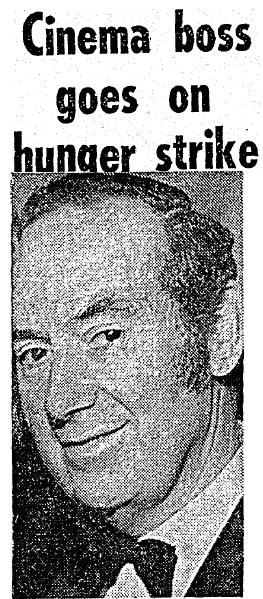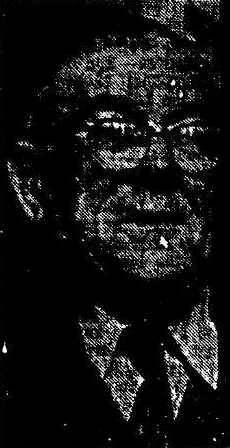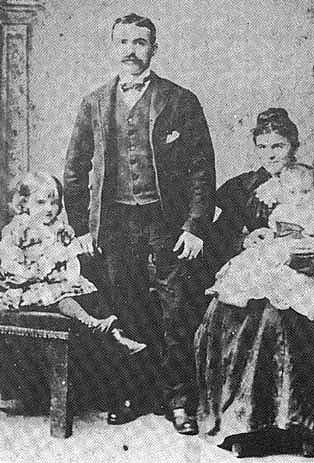This is sheer brilliance from the lads at Storymap and Shane MacThomais, historian at Glasnevin Cemetery. It tells the story of a UVF man buried among some of our own ‘patriot dead’.
There were a number of highly significant and influential one-day and two-day Punk and New Wave festivals from mid 1977 to late 1978 in Dublin.
The first was the Belfield Festival in UCD which took place on 25 June 1977. The line up was The Radiators from Space, The Undertones, The Vipers, Revolver and The Gamblers. Sadly the gig is perhaps best known for the tragic fatal stabbing which took place on the night.
Secondly, there was the first annual New Wave Festival which took place over two nights in The Project Arts Centre on 8 – 9 November 1977. The first night saw The Vipers and The Gamblers and the second night Revolver, Fabulous Fabrics and The Kamikaze Kids.

Paul Boyle (The Vipers), Steve Jones (The Sex Pistols), George Sweeney (The Vipers) & Larry Mullen (U2) at the Hot Press Xmas Party, '78. (Picture: U2TheEarlyDaze)
Thirdly, there was the one day Punk Festival on 28 November 1978 in St. Anthony’s Hall on the quays. The line up was The New Versions, Berlin, Virgin Prunes, Strange Movements, the Skank Mooks and The Citizens.
Anyone have any memories, pictures or gig posters of the above, please do get in touch.
Posted in Dublin History, Music | 3 Comments »
Interesting photo posted to Facebook, the inevitable fall out with local business for Occupy Dame Street?
Posted in Uncategorized | 7 Comments »
Mark O’Brien in his 2001 book De Valera, Fianna Fáil and the Irish Press makes fleeting reference to an Irish Press reporter named Paddy Clare who ‘took sabbatical leave’ [1] in order to join the International Brigade during the Spanish Civil War.
Immediately, I became fond of this chap who decided to take a ‘leave of absence’ from work, not to go on holiday but to join the International Brigade and his risk his life in the defence of the Second Spanish Republic.
A bit of digging unearthed that Clare was firstly, a life long Irish Republican who fought in both the War of Independence and in the Civil War on the Anti-Treaty side and secondly, an individual who has largely been forgotten.
Born in Dublin into a republican family in 1908, his father Mick was an old Fenian. Joining Na Fianna Éireann in his early teens, he saw action in Dublin during the War of Independence. Following the treaty, he took the Republican side in the Civil War and was a member of the Four Courts garrison in 1922. Subsequently, he was imprisoned in both Kilmainham and Mountjoy where, in the latter, he once went on hunger strike. [2]
Always a keen writer, Clare contributed articles to An Phoblact and The Nation. His work caught the eye of De Valera who asked him to join the fledgling Irish Press in 1931. He would stay with the paper for the next forty-three years, first as diary clerk, then a reporter and finally as ‘night-town man’.
Still committed to Irish Republican Socialist politics, he made the decision to take a period of leave from the newspaper to join the International Brigade.
Unfortunately that is all I know about his involvement in the SCW. I’ve emailed Ciaran Crossey (from the Irish SCW website) to see if he has any more information
Returning to Dublin and to The Irish Press, he was appointed as the paper’s ‘night-town’ reporter, a post in which he’d keep until 1973. A tough job, Clare would man the office throughout the night and chase any leads or stories that occurred during the hours of darkness.
Clare passed away in 1983 at the age of seventy-five. Tim-Pat Coogan wrote at the time:
Gravely voiced, indefatigably cheerful, with the yellow pallor of the night worker, which he was for scores of years, Paddy Clare to generations of young Irish Press journalists, epitomised the ideal of the hard-shelled, heart-of-gold professional reporter.
An IRA veteran of at least two wars (possibly three) and a respected journalist of over forty years, Clare lived a full life.
–
1 Mark O’Brien, De Valera, Fianna Fáil and the Irish Press (Dublin, 2001), 68
2 Unknown, Death of Paddy Clare, Irish Press, Mar 1, 1983
Posted in Dublin History | 1 Comment »
The most popular posting in the history of Come Here To Me?
It was the story of Broombridge train station, the sheer state of the place, and the campaign for Broombridge to win the Irish Rail station of the year. There was just something incredibly Irish about Irish Rail even asking ‘hey, which of our stations do you think is the best?’ as opposed to ‘which stations really need a lick of paint?’
At the time we wrote:
Anyone who has been through Broombridge station will know it is beyond the words ‘awful kip’, a station neglected while those around her have been modernised, she continues to crumble, the very station sign telling you where you are difficult to read.
Brrombridge winning the ‘Best Station’ award would draw some attention to the sheer state of the place, and be the best coup for a public vote campaign since the BBC had to award the Wolfe Tones the best song of the last century
It emerged out of a Facebook campaign which caught our attention, and the story seemed to grow legs from there, with our original story posted by Broadsheet.ie and Colm O’Rourke, the man behind the Facebook campaign, interviewed by the Irish Daily Mail.
Thousands of you read the piece, but more importantly a very sizable chunk of you went on to visit the Irish Rail website and vote for Broombridge, something you can still do and should still do by clicking here.
Today I came home to an e-mail from Come Here To Me reader Ado with some great news regarding Iarnród Éireann:
Iarnrod Eireann today started cleaning up the Broombridge train station, new paintwork, signs, markings etc.., Nothing major but they are reacting to the email voting campaign. Well done to all involved.
He went on to note below:
The fact is we, the local Community Council, were informed by IE management in December that no upgrade was planned for Broombridge due to vandalism. A pathetic reason for abandoning our station. It’s IE’s duty to secure their property and maintain it to the same standards of every other station.
Nothing major indeed, but it is a start. Historically overlooked, even during times of renovation, it’s great that thousands of people have taken the time to register their protest with Irish Rail over the sheer state of Broombridge. For many Dubliners, Broombridge is the local train station remember. It’s just not up to scratch.
Posted in Events | 5 Comments »
A bit later than normal getting this up, but just to flag that the new Look Left is in stores now…

Look Left
LookLeft 9 – only €2 – includes;
Reports on student protests, Occupy Dame Street, turf wars in Kildare, AFA action against Nick Griffin, defending health services, the community fight against drugs, Occupy Wall Street, the sex industry, doctors in El Salvador, Ship to Gaza, turmoil in Egypt, the Greek Communist Party , Belfast’s Fresh Claim Café, WP Northern Ireland conference
Interviews with PUP leader Billy Hutchinson, America Radical Fred Magdoff, Rapper Captain Moonlight
Main Feature; Ireland’ addiction to low corporation tax and Corporate Imperialism
Features; Occupy – where to now, Revolution in Cork City FC, Friedrich Engels on Ireland, Irish Graphic Novels, book reviews, the Jemmy Hope Column and Around the Left (news from progressive organisations)
Views; WP President Mick Finnegan on Budget 2012, Socialist Party MEP Paul Murphy on the need for an EU referendum
Posted in Events, Miscellaneous, Reviews | 1 Comment »
Great stuff from Maser, this is painted onto the side of the Dublin Simon Community shop on Camden Street in Dublin 2, and like the prior featured piece from ADW, is a part of the First Fortnight mental health awareness project.
Maser has been bringing good vibes to the city for years now, from the They Are Us collaboration with Damien Dempsey to his projected show on the side of the convention centre, a love letter to the city almost. He also dabbles on occasion in more traditional acts like signwriting. The shopfront writing of Kevin Freeney and the like is a Come Here To Me feature which will have to be done down the line of course, but for now we’re always happy to post the latest from the contemporary artists of the city. Nice one Maser.
Posted in Street Art | 1 Comment »
Twitter really is awful when you’ve work to do. Surreal stuff all the same. “Something only we three would know”
Posted in Uncategorized | Leave a Comment »
My thanks to Paula Geraghty of Trade Union TV for these images from Liffey Valley Shopping Centre. Workers from the Grafton Street, Henry Street and Dundrum branches have joined workers at the Liffey Valley branch. Staff who have found themselves out of work have, according to The Irish Times report on the sit-in, not even received P45’s to allow them to seek social welfare payments.
It goes without saying we wish the workers every success. The Facebook page in support of the workers can be found here.
It seems fitting to highlight the fact too that Vita Cortex workers, also staging a sit-in at their place of work, will be staging a demonstration at the Dáil this Thursday from 1pm.
Posted in Photography | Leave a Comment »
Well, this has potential to be quite the debate. The latest Hedge School from History Ireland takes place this Wednesday at the National Library, it’s likely to fill-up and places are first come first served. Here on the site you can find audio from previous Hedge Schools, on topics such as Brian Boru and the Battle of Clontarf and also a previous Hedge School in the National Library at which I spoke around the Animal Gang.
We’re now into the ‘decade of centenaries’ of course, but just what we’re commemorating is going to be the subject of great debate. It’s a debate we should all involve ourselves in.
History Ireland Hedge School in association with The National Library, Kildare St., Dublin @Wednesday 11 January 2012, 7pm
The War of Independence: ‘four glorous years’ or squalid sectarian conflict? Was historic objectivity the real victim?
The War of Independence 1918-1921 will be commemorated later this decade. Was it ‘Four Glorious Years’, as one protagonist called it (Frank Gallagher, the deputy director of the first Dáil’s Department of Publicity). Or was it a sectarian conflict darkened by ethnic cleansing, as historian Peter Hart has asserted (The IRA and its Enemies. 1998)?
Speakers: Historians John M. Regan (University of Dundee), David Fitzpatrick (TCD), Eve Morrison (TCD) and John Borgonovo (UCC).
Posted in Events | 13 Comments »

















 Click on the book for more.
Click on the book for more. Click on the book for more.
Click on the book for more.